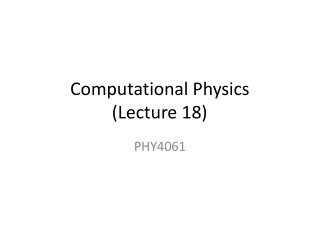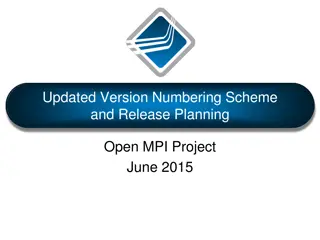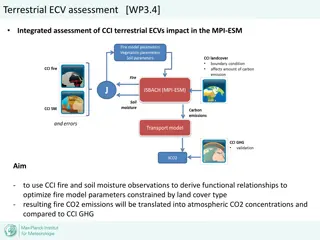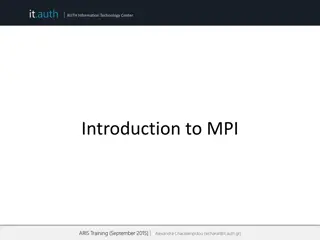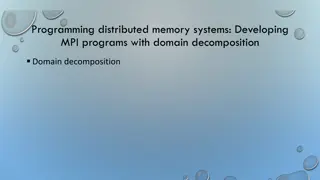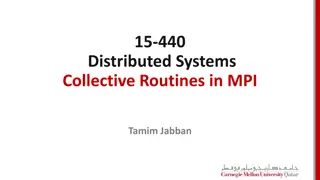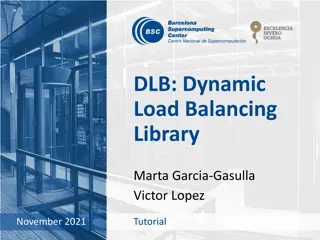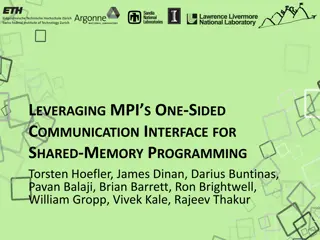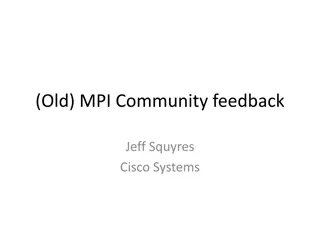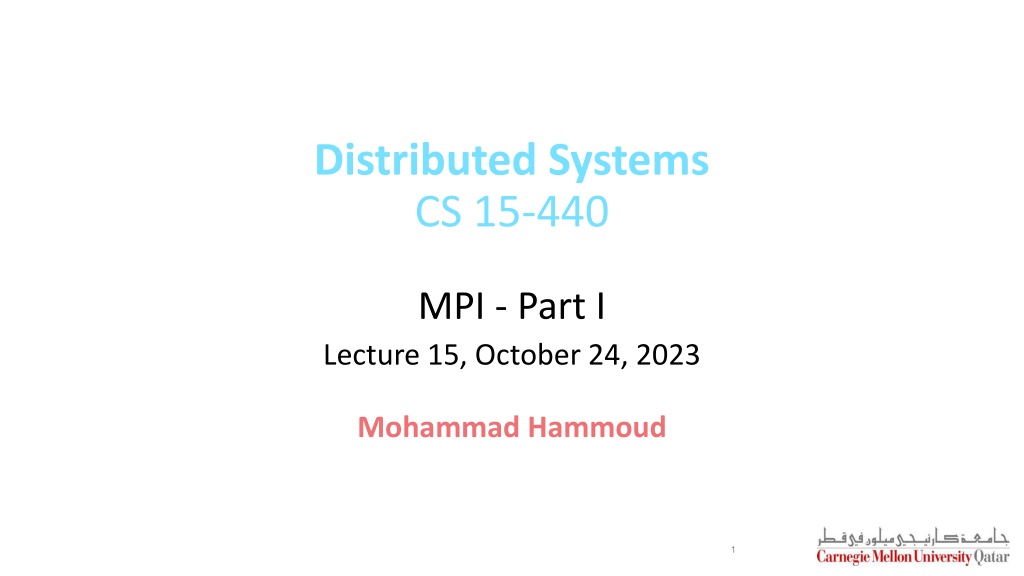
Understanding Parallel Programming Models in Distributed Systems
Learn about parallel programming models in distributed systems, including shared memory and message passing, and how they enable efficient computation and communication among parallel tasks. Explore the concepts of synchronization, fault tolerance, and networking in the context of distributed systems.
Download Presentation

Please find below an Image/Link to download the presentation.
The content on the website is provided AS IS for your information and personal use only. It may not be sold, licensed, or shared on other websites without obtaining consent from the author. Download presentation by click this link. If you encounter any issues during the download, it is possible that the publisher has removed the file from their server.
E N D
Presentation Transcript
Distributed Systems CS 15-440 MPI - Part I Lecture 15, October 24, 2023 Mohammad Hammoud 1
Today Last Session: Synchronization Part IV Today s Session: MPI Part I Announcements: P2 is due today by midnight P3 will be released on Thursday, Oct 26 We will practice on MPI in the upcoming recitation
Course Map Applications Programming Models Fast & Reliable or Efficient DS Replication & Consistency Fault-tolerance Communication Paradigms Architectures Naming Synchronization Correct or Effective DS Networks
Course Map Applications Programming Models Replication & Consistency Fault-tolerance Communication Paradigms Architectures Naming Synchronization Networks
Models of Parallel Programming What is a parallel programming model? It is an abstraction provided by a system to programmers so that they can use it to implement their algorithms It determines how easily programmers can translate their algorithms into parallel units of computations (i.e., tasks) It determines how efficiently parallel tasks can be executed on the system 5
Traditional Parallel Programming Models Parallel Programming Models Shared Memory Message Passing 6
Shared Memory Model In the shared memory programming model, the abstraction provided implies that parallel tasks can access any location of the memory Accordingly, parallel tasks can communicate through reading and writing common memory locations This is similar to threads in a single process (in traditional OSs), which share a single address space Multi-threaded programs (e.g., OpenMP programs) use the shared memory programming model 7
Shared Memory Model Single Thread Multi-Thread Si = Serial Pj = Parallel Time Time Spawn S1 S1 P1 P3 P1 P2 P3 P2 Join P3 S2 Shared Space P4 S2 Process Process 8
Traditional Parallel Programming Models Parallel Programming Models Shared Memory Message Passing 9
Message Passing Model In message passing, parallel tasks have their own local memories One task cannot access another task s memory Hence, tasks have to rely on explicit message passing to communicate This is similar to the abstraction of processes in a traditional OS, which do not share an address space Example: Message Passing Interface (MPI)
Message Passing Model Message Passing Single Thread Si = Serial Pj = Parallel Time Time S1 S1 S1 S1 S1 P1 P1 P1 P1 P1 P2 S2 S2 S2 S2 P3 P4 Process 0 Process 1 Process 2 Process 3 S2 Node 1 Node 2 Node 3 Node 4 Process 11
Shared Memory vs. Message Passing Comparison between the shared memory and message passing programming models along several aspects: Aspect Aspect Aspect Aspect Aspect Shared Memory Shared Memory Shared Memory Shared Memory Shared Memory Message Passing Message Passing Message Passing Message Passing Message Passing Communication Communication Communication Communication Communication Implicit (via loads/stores) Implicit (via loads/stores) Implicit (via loads/stores) Implicit (via loads/stores) Implicit (via loads/stores) Explicit Messages Explicit Messages Explicit Messages Explicit Messages Explicit Messages Synchronization Synchronization Synchronization Synchronization Synchronization Explicit Explicit Explicit Explicit Explicit Implicit (Via Messages) Implicit (Via Messages) Implicit (Via Messages) Implicit (Via Messages) Implicit (Via Messages) Hardware Support Hardware Support Hardware Support Hardware Support Hardware Support Typically Required Typically Required Typically Required Typically Required Typically Required None None None None None Development Effort Development Effort Development Effort Development Effort Development Effort Lower Lower Lower Lower Lower Higher Higher Higher Higher Higher Tuning Effort Tuning Effort Tuning Effort Tuning Effort Tuning Effort Higher Higher Higher Higher Higher Lower Lower Lower Lower Lower 12
Message Passing Interface MPI Point-to-Point Communication Collective Communication A Primer 13
What is MPI? MPI is a standard message passing model for developing message passing programs The objective of MPI is to establish a portable, efficient, and flexible libraries for message passing By itself, MPI is NOT a library - but rather a specification of what an MPI library should be MPI is not an IEEE or ISO standard, but has in fact, become the industry standard for writing message passing programs on HPC platforms 14
Reasons for using MPI Reason Reason Reason Reason Reason Description Description Description Description Description MPI is the only message passing library which can be considered a standard. It is supported on virtually all HPC platforms standard. It is supported on virtually all HPC platforms standard. It is supported on virtually all HPC platforms standard. It is supported on virtually all HPC platforms standard. It is supported on virtually all HPC platforms MPI is the only message passing library which can be considered a MPI is the only message passing library which can be considered a MPI is the only message passing library which can be considered a MPI is the only message passing library which can be considered a Standardization Standardization Standardization Standardization Standardization There is no need to modify your source code when you port your application to a different platform that supports the MPI standard application to a different platform that supports the MPI standard application to a different platform that supports the MPI standard application to a different platform that supports the MPI standard There is no need to modify your source code when you port your There is no need to modify your source code when you port your There is no need to modify your source code when you port your Portability Portability Portability Portability Vendor implementations should be able to exploit native hardware features to optimize performance features to optimize performance features to optimize performance Vendor implementations should be able to exploit native hardware Vendor implementations should be able to exploit native hardware Performance Opportunities Performance Opportunities Performance Opportunities Functionality Functionality Over 115 routines are defined Over 115 routines are defined A variety of implementations are available, both vendor and public domain Availability 15
Communicators MPI uses objects called communicators/groups to define which collection of processes may communicate with each other to solve a certain problem MPI_COMM_WORLD is a predefined communicator that includes all of your MPI processes But a problem can consist of several sub-problems where each can be solved independently Thus, you can create a new communicator for each sub-problem as a subset of an existing communicator 16
Ranks Within a communicator, every process has its own unique ID referred to as rank, assigned by the system when the processes are initialized A rank is sometimes called a task ID-- ranks are contiguous and begin at zero frommpi4pyimport MPI Ranks are used by programmers to specify the sources and destinations of messages comm = MPI.COMM_WORLD rank = comm.Get_rank() print('My rank is ',rank) Ranks are often used conditionally in programs to control execution (e.g., if rank=0 do this / if rank=1 do that) 17
Example Consider a problem with a fluid dynamics part and a structural analysis part, where each part can be computed in parallel MPI_COMM_WORLD Comm_Fluid Comm_Struct Rank=0 Rank=1 Rank=0 Rank=1 Rank=0 Rank=1 Rank=4 Rank=5 Rank=2 Rank=3 Rank=2 Rank=3 Rank=2 Rank=3 Rank=6 Rank=7 Ranks within MPI_COMM_WORLD are printed in red Ranks within Comm_Fluid are printed in green Ranks within Comm_Struct are printed in blue
Message Passing Interface MPI Point-to-Point Communication Collective Communication A Primer 19
How is Point-to-Point Communication Performed? Process 0 Sender 1) The user stores data in the user buffer 1) The system receives the data from the source process and copies it to the system buffer User Mode Kernel Mode sendbuf 1 sysbuf 2 3 Call a send routine Copying data from sendbuf to sysbuf 2) The user calls one of the MPI send routines Send data from sysbuf to destination Now sendbuf can be reused 2) The user calls one of the MPI receive routines 4 3) The system copies the data from the user buffer to the system buffer Data Process 1 Receiver 3) The system copies the data from the system buffer to the user buffer User Mode Kernel Mode Receive data from source to sysbuf Call a recev routine 2 1 4) The system sends the data from the system buffer to the destination process sysbuf 4 Now recvbuf contains valid data 4) The user uses the data in the user buffer Copying data from sysbuf to recvbuf recvbuf 3
Blocking and Non-Blocking Send and Receive A distinction is typically made between blocking and non-blocking point-to-point communication routines A blocking send will only return after it is safe to modify the application buffer for reuse This means that any modification to the sendbuf will not affect the data intended for the receiver But it does not mean that the data was received by the receiver The data may still be residing at the system buffer on the sender side Now safe to modify the sendbuf Rank 0 Rank 1 sendbuf recvbuf Network recvbuf sendbuf 21
Blocking and Non-Blocking Send and Receive A blocking send can be: Synchronous: A handshake will occur between the sender and the receiver Asynchronous: No handshake will occur between the sender and the receiver, but the system buffer at the sender will still hold the data for eventual delivery to the receiver A blocking receive only returns after the data is received by the receiver (i.e., stored at the receiver s application recvbuf) and is ready for use by the user 22
Blocking and Non-Blocking Send and Receive Non-blocking send and non-blocking receive behave similarly They return almost immediately They do not wait for any communication events to complete such as: Message copying from application buffer to system buffer Or the actual arrival of a message However, if you use the application buffer before the copy completes: Incorrect data may be copied to the system buffer (in case of non-blocking send) Or application buffer will not contain what you want (in case of non-blocking receive) You can ensure the completion of copy by using MPI_WAIT() after the send or receive operations 23
Point-To-Point Communication: An Example frommpi4pyimport MPI These methods (or routines) can communicate general Python objects -- to communicate memory buffers, you can use comm.Send( ) and comm.Recv( ) comm = MPI.COMM_WORLD rank = comm.Get_rank() if rank == 0: elif rank == 1: data = {'a': 7, 'b': 3.14} comm.send(data, dest=1, tag=11) The tag information allows selectivity of messages at the receiving end data = comm.recv(source=0, tag=11) Blocking send & blocking receive 24
Point-To-Point Communication: An Example frommpi4pyimport MPI frommpi4pyimport MPI comm = MPI.COMM_WORLD rank = comm.Get_rank() comm = MPI.COMM_WORLD rank = comm.Get_rank() Indicate that they are non-blocking if rank == 0: elif rank == 1: if rank == 0: data = {'a': 7, 'b': 3.14} comm.send(data, dest=1, tag=11) data = {'a': 7, 'b': 3.14} req = comm.isend(data, dest=1, tag=11) req.wait() elif rank == 1: req = comm.irecv(source=0, tag=11) data = req.wait() data = comm.recv(source=0, tag=11) Blocking send & blocking receive Non-blocking send & non-blocking receive 25
Bidirectional Communication When two processes exchange data with each other, there are essentially 3 cases to consider: Case 1: Both processes call the send routine first, then the receive routine We will refer to this communication pattern as SS-RR Rank 0 Rank 1 sendbuf recvbuf Case 2: Both processes call the receive routine first, then the send routine We will refer to this communication pattern as RR-SS recvbuf sendbuf Case 3: One process calls the send and receive routines (in this order), and the other calls them in the opposite order We will refer to this communication pattern as SR-RS 26
Bidirectional Communication To this end, deadlocks can arise: 1. Either due to an incorrect order of send and receive 2. Or due to a limited size of the system buffer Consider the following two snippets of pseudo-code that use the SS-RR pattern: IF (myrank==0) THEN CALL MPI_ISEND(sendbuf, , ireq, ) CALL MPI_WAIT(ireq, ) CALL MPI_RECV(recvbuf, ) ELSEIF (myrank==1) THEN CALL MPI_ISEND(sendbuf, , ireq, ) CALL MPI_WAIT(ireq, ) CALL MPI_RECV(recvbuf, ) ENDIF IF (myrank==0) THEN CALL MPI_SEND(sendbuf, ) CALL MPI_RECV(recvbuf, ) ELSEIF (myrank==1) THEN CALL MPI_SEND(sendbuf, ) CALL MPI_RECV(recvbuf, ) ENDIF SS RR 27
Bidirectional Communication: The SS SS- -RR RR Pattern What happens if the system buffer is larger than the send buffer? What happens if the system buffer is smaller than the send buffer? Rank 0 sendbuf Rank 1 sendbuf Network sysbuf sysbuf recvbuf recvbuf
Bidirectional Communication: The SS SS- -RR RR Pattern What happens if the system buffer is larger than the send buffer? What happens if the system buffer is smaller than the send buffer? DEADLOCK! Rank 0 sendbuf Rank 1 Rank 0 sendbuf Rank 1 sendbuf sendbuf Network Network sysbuf sysbuf sysbuf sysbuf recvbuf recvbuf recvbuf recvbuf
Bidirectional Communication: The SS SS- -RR RR Pattern Consider the following pseudo-code: Is it free from deadlocks? Yes IF (myrank==0) THEN CALL MPI_ISEND(sendbuf, , ireq, ) CALL MPI_RECV(recvbuf, ) CALL MPI_WAIT(ireq, ) ELSEIF (myrank==1) THEN CALL MPI_ISEND(sendbuf, , ireq, ) CALL MPI_RECV(recvbuf, ) CALL MPI_WAIT(ireq, ) ENDIF
Bidirectional Communication: The RR RR- -SS SS Pattern Can the following pseudo-code lead to a deadlock? A deadlock will occur regardless of how big the system buffer is IF (myrank==0) THEN CALL MPI_RECV(recvbuf, ) CALL MPI_SEND(sendbuf, ) ELSEIF (myrank==1) THEN CALL MPI_RECV(recvbuf, ) CALL MPI_ISEND(sendbuf, ) ENDIF What if we use a non-blocking send instead of a blocking send above? A deadlock will still occur
Bidirectional Communication: The RR RR- -SS SS Pattern Can the following pseudo-code lead to a deadlock? No, it uses non-blocking receive IF (myrank==0) THEN CALL MPI_IRECV(recvbuf, , ireq, ) CALL MPI_SEND(sendbuf, ) CALL MPI_WAIT(ireq, ) ELSEIF (myrank==1) THEN CALL MPI_IRECV(recvbuf, , ireq, ) CALL MPI_SEND(sendbuf, ) CALL MPI_WAIT(ireq, ) ENDIF
Bidirectional Communication: The SR SR- -RS RS Pattern What about the following pseudo-code? It is always safe to order the calls of MPI_(I)SEND and MPI_(I)RECV at the two processes in the opposite order In this case, we can use either blocking or non-blocking routines IF (myrank==0) THEN CALL MPI_SEND(sendbuf, ) CALL MPI_RECV(recvbuf, ) ELSEIF (myrank==1) THEN CALL MPI_RECV(recvbuf, ) CALL MPI_SEND(sendbuf, ) ENDIF
Message Passing Interface MPI Point-to-Point Communication Collective Communication A Primer 34
Collective Communication Collective communication allows exchanging data among a group of processes It must involve all processes in the scope of a communicator The calling communicator (in Python) or the communicator argument (in C) should specify which processes are involved in the communication As such, it is the programmer's responsibility to ensure that all processes within a communicator participate in any collective operation 35
Patterns of Collective Communication There are several patterns of collective communication: 1. Broadcast 2. Scatter 3. Gather 4. Allgather 5. Alltoall 6. Reduce 7. Allreduce 8. Scan 9. Reducescatter 36
1. Broadcast Broadcast sends a message from the process with rank root to all other processes in the group Data Data Process Process P0 P0 A A Broadcast P1 P1 A P2 P2 A P3 P3 A In C: int MPI_Bcast ( void *buffer, int count, MPI_Datatype datatype, int root, MPI_Comm comm ) To broadcast general Python objects In Python: bcast(obj, root=0) To broadcast memory buffers Bcast(buf, root=0) 37
2-3. Scatter and Gather Scatter distributes distinct messages from a single source task to each task in the group Data Data Process Process P0 P0 A B C D A Scatter P1 P1 B P2 P2 C P3 P3 D int MPI_Scatter ( void *sendbuf, int sendcnt, MPI_Datatype sendtype, void *recvbuf, int recvcnt, MPI_Datatype recvtype, int root, MPI_Comm comm ) In C: In Python: To scatter general Python objects scatter(sendobj, root=0) To scatter memory buffers Scatter(sendbuf, recvbuf, root=0)
2-3. Scatter and Gather Scatter distributes distinct messages from a single source task to each task in the group Gather gathers distinct messages from each task in the group to a single destination task Data Data Process Process P0 P0 A B C D A Scatter P1 P1 B P2 P2 C P3 P3 D Gather int MPI_Gather ( void *sendbuf, int sendcnt, MPI_Datatype sendtype, void *recvbuf, int recvcount, MPI_Datatype recvtype, int root, MPI_Comm comm ) In C: In Python: To gather general Python objects gather(sendobj, root=0) To gather memory buffers Gather(sendbuf, recvbuf, root=0)
4. All Gather Allgather gathers data from all tasks and distributes them to all tasks Each task in the group, in effect, performs a one-to-all broadcasting operation within the group Data Data Process Process P0 P0 A A B C D allgather P1 P1 B A B C D P2 P2 C A B C D P3 P3 D A B C D int MPI_Allgather ( void *sendbuf, int sendcount, MPI_Datatype sendtype, void *recvbuf, int recvcount, MPI_Datatype recvtype, MPI_Comm comm ) In C: To gather general Python objects In Python: allgather(sendobj) To gather data from all processes and distribute it to all other processes in a group Allgather(sendbuf, recvbuf)
6-7. Reduce and All Reduce Reduce applies a reduction operation on all tasks in the group and places the result in one task Data Data Process P0 Process P0 A A*B*C*D Reduce P1 P1 B P2 C P2 P3 D P3 int MPI_Reduce ( void *sendbuf, void *recvbuf, int count, MPI_Datatype datatype, MPI_Op op, int root, MPI_Comm comm ) In C: In Python: To reduce general Python objects reduce(sendobj, op=SUM, root=0) To reduce vals from mem buffers Reduce(sendbuf, recvbuf, op=SUM, root=0)
6-7. Reduce and All Reduce Reduce applies a reduction operation on all tasks in the group and places the result in one task Allreduce applies a reduction operation and places the result in all tasks in the group. This is equivalent to an MPI_Reduce followed by an MPI_Bcast Data Data Data Data Process Process P0 P0 Process Process P0 P0 A A A*B*C*D A*B*C*D Reduce Allreduce P1 P1 P1 P1 B B A*B*C*D P2 P2 C C P2 P2 A*B*C*D P3 P3 D D P3 P3 A*B*C*D int MPI_Allreduce ( void *sendbuf, void *recvbuf, int count, MPI_Datatype datatype, MPI_Op op, MPI_Comm comm ) In C: To allreduce general Python objects In Python: allreduce(sendobj, op=SUM) To allreduce values from memory buffers Allreduce(sendbuf, recvbuf, op=SUM)
Next Lecture MPI- Part II (Case Studies on Search Engines and PageRank) 44

